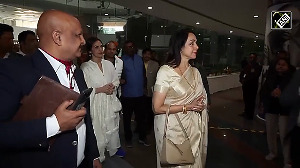
A new dance exercise routine promises to make workout fun. Manavi Kapur checks it out.

Photograph: Edson Hong/Creative Commons
I walk into an exercise studio at iFitness Gym in New Delhi's GreenPark that is occupied by hesitant and sceptical women. There seems to be an air of nervousness about what is to follow when Bharat Sadana walks into the room and shouts, "Bags out!"
There's just enough time for people to take their places before some pumped up Bollywood numbers blare from the speakers and the action begins.
This is a Crush Cardio class, which entails about 45 minutes of dancing followed by a 15-minute stretching session.
It doesn't seem very challenging when the class begins with simple neck, arms, legs and hip warm-up exercises. But I'm less smug about 20 minutes into the routine, sweating buckets and stopping frequently to catch my breath. Conceptualised by Sadana, Uday Raj Anand, Neha Bedi and Rajat Bedi - the four co-founders of Crush Fitness India - the idea behind this workout is to get people to break the monotony of usual gym workouts and lose their inhibitions.
Losing one's inhibitions can be harder than it sounds, especially when I can see myself in the mirror, struggling to follow steps despite some basic training in jazz and Bharatnatyam.
Anand explains that the point of the workout is to not learn a dance form - Crush combines four to six dance forms in one routine, including some latkas, jhatkas and pelvic thrusts in Bhojpuri style - but to get your body moving and your heart racing. "That is why we never correct someone's dance steps. This routine is more about connecting with the instructor and with the high energy in the room," he explains.
The choice of music for this workout also seems to work in its favour. Unlike trance, which is more suited to pumping iron, Crush uses popular numbers, including Bollywood and Punjabi songs, which most of the people can lip-sync, even if they would never admit to be able to do that in public.
The routine follows no set pattern and Sadana insists that it is completely impromptu. I do notice a few steps being repeated during the class, perhaps meant to work a particular muscle group.
While Anand and Sadana tell me that their trainers go through intensive orthopaedic training and take note of a person's prior injuries, I wonder how much of it is actually practised during a session.
Once a class begins, there is only so much time the instructors have to observe one's posture.
For example, if one's knees jut out beyond one's toes while squatting, it can lead to a serious knee injury. These are the basics I learnt during my dance training, but these instructions seemed lacking during the Crush class.
Though the steps are simple, there are a few jumps and jerky movements that could prove problematic for someone with back or knee problems.
The only way around this seems to let the instructors know about one's issues before a class begins. When I share these reservations with Sadana, he shows me a video of a 60-year-old woman at a Crush Cardio class. "You don't need to jump if you can't and do as much as your body allows you," he explains.
What also stood out was the fact that the class focussed on an intensive stretching session right at the end.
This, says Anand, is to conserve energy levels and make the most of them during the cardio workout. "Dancers stretch before for specific reasons such as lengthening their joints and getting the right posture. For us, the focus is purely on fitness," he says.
While I can agree with that, improper and inadequate stretching before a dance routine can cause problems of its own.
An exercise regime is about expending energy in controlled movements, which, I reckon, one can achieve at Crush only after the first few weeks. But there's no denying that it is a mad, fun way to let off steam.

Photograph: Aktiv I Oslo.no/Creative Commons
Right foot forward
According to Samridhi Saxena, senior physical therapist at AktivOrtho, a Delhi-based orthopaedic and physiotherapy centre, a good dancer needs a strong core that includes strong abdominal musculature, strength in lower back, hip muscles, knees, feet and ankles, along with good stability of joints and flexibility of muscles. This would need dancers to do exercises that improve balance and coordination.
Dancers are also prone to ankle and knee injuries, which, if left unattended, can get worse over time. "The muscles around the ankles and knees should then be strengthened to give those joints extra support," explains Saxena. This means that muscles of the legs and hips should be put through a proper warm-up routine. "Those with prior injuries can also dance, but it is best to get your doctor's clearance before doing so," she says.
Dancing to fitness
Several dance-based workouts have emerged in the past few years, primarily because gym-goers find it boring to stick to the same gym routine.
Created by Colombian dancer and choreographer Alberto Perez during the 1990s, Zumba is a wildly popular dance fitness regime. Different categories within the programme cater to different age groups and fitness levels. Typically, a Zumba session is an hour long.
Ballet-inspired dance classes can be a great way to learn a dance form while increasing flexibility and core strength. In India, jazz classes rely on exercise routines such as Pilates to correct posture and tone up major muscle groups. The classes aim a balance between cardio and stretching.
Also See











